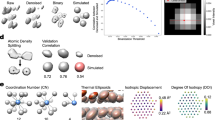Abstract
Small atomic assemblies (diameter 10–100 Å) possess several unusual physical and catalytic properties1–9. Speculations regarding the crystalline nature of individual particles of supported metals dispersed to this degree, as well as colloidal metallic sols, date back to Faraday's researches on divided metals. Interest has been renewed following the demonstration10,11 that metals could readily be prepared in colloidal form. Similarly, binary semiconductors such as CdS exhibit novel properties which are of potential value in photoelectrochemistry. Thus, the electronic band-gap of bulk CdS is 2.4 eV, whereas a CdS cluster of ∼18° diameter—corresponding to one of the ‘magic agglomeration numbers’—has a band-gap closer to 3.4 eV. Moreover, the conduction-band edges of such ultrafine semiconductors functioning as microelectrodes are sufficiently shifted to favour the photoreduction of H+ (as gaseous H2) from water4. Reliable methods are needed to probe the ultrastructure of very fine particles, especially as such methods can elucidate the nature of many other ultrafine materials. Examples of such materials are: (1) bimetallic systems8, such as Pt/Ir on oxide supports for the catalytic re-forming of hydrocarbons to improve octane ratings; (2) semiconductors such as TiO2 overlaid with comminuted Pt for the photocleavage of water12,14; (3) dispersed Rh or Pt on oxide supports for controlling automobile exhausts15; and (4) large clusters of transition metal and noble metals of the type Au55 [P(C6H5)3]12Cl6, which bridge the gap between molecular and extended metallic structures6. High-resolution electron microscopy is a possibility as it probes structures directly in real-space16–18. Very-high-voltage transmission electron microscopes (TEM), operating between 400 and 1,500 keV, would provide the best interpretable resolution; however, they cannot usually be fitted with in situ micro-analytical facilities based on X-ray emission—essential for sample characterization of mixed phases—and voltage stability is harder to achieve as accelerating voltage increases. Here we report results obtained with a modified commerical 200-keV TEM. A new type of side-entry specimen stage permits the investigation of atomic arrays in minute assemblies of Au and in colloidal catalysts of Pt, such as those used in photoredox processes4,19,20. These are shown to be crystalline but relatively rich in disordered regions, both within their bulk and on their surface.
This is a preview of subscription content, access via your institution
Access options
Subscribe to this journal
Receive 51 print issues and online access
$199.00 per year
only $3.90 per issue
Buy this article
- Purchase on Springer Link
- Instant access to full article PDF
Prices may be subject to local taxes which are calculated during checkout
Similar content being viewed by others
References
Fojtik, A., Weller, H., Koch, U. & Hengelein, A. Ber. Bunsenges phys. Chem. 88, 969–974 (1984).
Brus, L. E. J. chem. Phys. 80, 4403–4409 (1984).
Thomas, J. K. & Wheeler, J. Chem. Phys. Lett. (in the press).
Nedeljković, J. M., Nenadovic, M. T., Mićić, O. I. & Nozik, A. J. J. phys. Chem. 90, 12–13 (1986).
Grätzel, M., Kalyanasundaram, K. & Kiwi, J. Structure Bonding, Berlin 49, 30–36 (1982).
Schmidt, G., Giebel, U., Huster, W. & Schwenk, A. Inorg. Chim. Acta 85, 97–102 (1984).
Wallenberg, L. R., Bovin, J.-O. & Schmid, G. Surf. Sci. 156, 256–264 (1985).
Sinfelt, J. H. Bimetallic Catalysts: Discoveries Concepts and Applications (Wiley, New York, 1983).
Millward, G. R. J. Catal 64, 381–396 (1980).
Rideal, E. K. J. Am. chem. Soc. 42, 749–756 (1920).
Schwab, G. M. . in Catalysis from the Standpoint of Chemical Kinetics 334 (Macmillan, London, 1937).
Kraeutler, B. & Bard, A. J. J. Am. chem. Soc. 100, 2239–2240 (1978).
Lehn, J. M. & Sauvage, J. P. Nouv. J. Chim. 1, 449–451 (1977).
Domen, K., Kudo, A., Onishi, T., Kosugi, N. & Kuroda, H. J. phys. Chem. 90, 292–295 (1986).
Lester, G. R. Am. chem. Soc. Publ. No. 222, 415 (1983).
Uyeda, N., Nishino, M. & Suito, E. J. Coll. Interface Sci. 43, 264–276 (1973).
Thomas, J. M. & Jefferson, D. A. Endeavour 2, 127–136 (1978).
Jefferson, D. A., Thomas, J. M., Cleaver, J. R. A. & Smith, D. J. Nature 281, 51–52 (1979).
Fujishima, A. & Honda, K. Nature 238, 37–38 (1972).
Harriman, A., Porter, G. & Richoux, M-C. JCS Faraday Trans. II, 78, 1955–1970 (1982).
Erickson, H. P. & Klug, A. Phil. Trans R. Soc. B261, 105–118 (1971).
Marks, L. D., Howie, A. & Smith, D. J. Inst. Phys. Conf. Ser. 52, 397–400 (1980).
Honda, T., Ibe, K., Suzuki, S., Ishida, Y. & Tsuno, K. Inst. Phys. Conf. Ser. 78, 579–582 (1985).
Tsuno, K. & Smith, K. C. A. Inst. Phys. Conf. Ser. 78, 121–124 (1985).
Budinger, T. F. & Glaeser, R. M. Ultramicroscopy 2, 31–41 (1976).
Bond, G. C. Trans. Faraday Soc. 52, 1235–1244 (1956).
Harriman, A., Porter, G. & Richoux, M. C. JCS Faraday Trans. II 77, 1939–1948 (1981).
Keryov, K. et al. Preprint (Univ. Cambridge, 1986).
Taylor, H. S. Proc. R. Soc. A108, 105–111 (1925).
Author information
Authors and Affiliations
Rights and permissions
About this article
Cite this article
Jefferson, D., Thomas, J., Millward, G. et al. Atomic structure of ultrafine catalyst particles resolved with a 200-keV transmission electron microscope. Nature 323, 428–431 (1986). https://doi.org/10.1038/323428a0
Received:
Accepted:
Issue Date:
DOI: https://doi.org/10.1038/323428a0
This article is cited by
-
HREM surface profile images of Bi2Sr2CaCu2O8
Journal of Superconductivity (1996)
-
HRTEM observation of metal particles mobility on a Pt/?-Al2O3 catalyst
Catalysis Letters (1994)
-
Superstructures in Ba0·6K0·4BiO3−y and BaPb1−x Bi x O3−y
Bulletin of Materials Science (1991)
-
Electron beam decomposition of copper hydride and the generation of ultra-fine particles of copper
Journal of Materials Science Letters (1989)
-
Direct imaging of an adsorbed layer by high-resolution electron microscopy
Nature (1988)
Comments
By submitting a comment you agree to abide by our Terms and Community Guidelines. If you find something abusive or that does not comply with our terms or guidelines please flag it as inappropriate.



